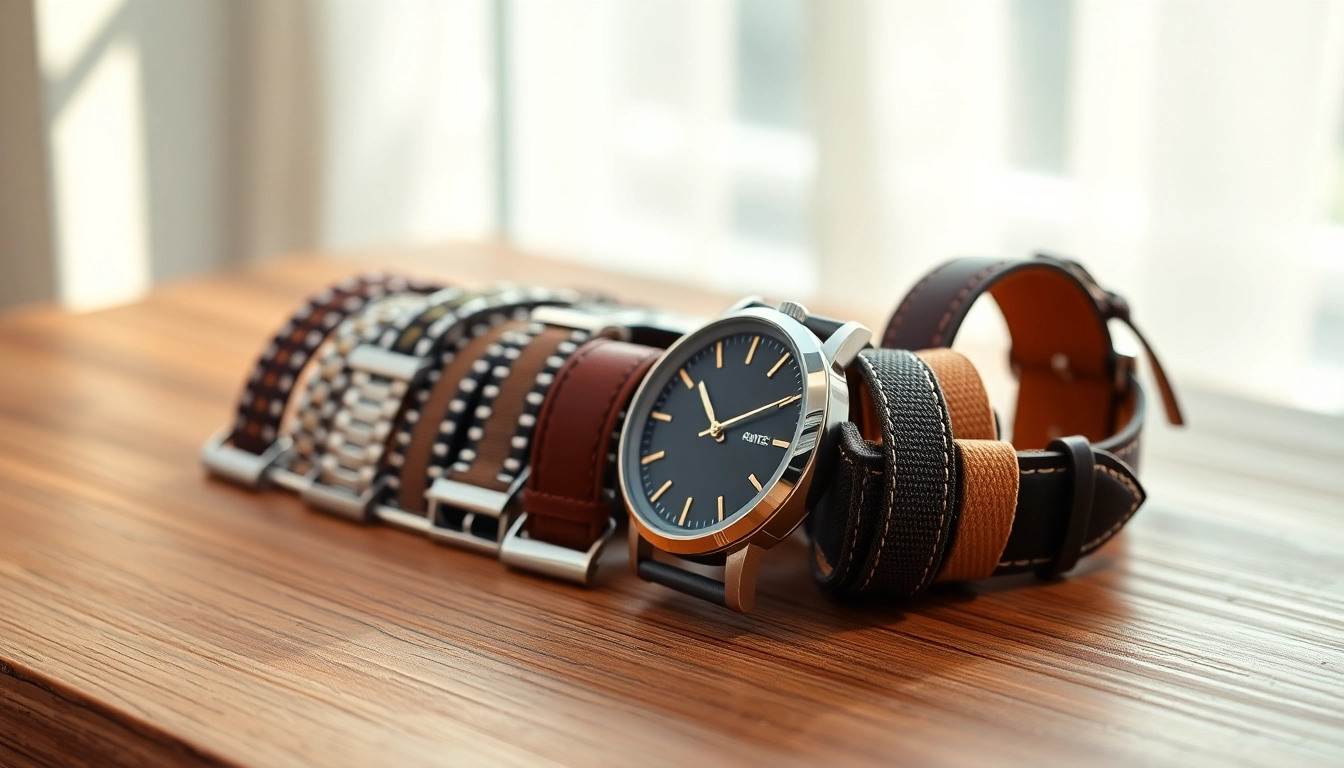Understanding Watch Bands
For anyone who wears a timepiece, the watch band is more than just a functional accessory; it’s a vital part of the watch itself. This seemingly simple element ties the watch to the wrist and can significantly impact the overall style and comfort. In a world where aesthetics, comfort, and functionality matter, your choice of watch band can make a noticeable difference. In this comprehensive guide, we’ll explore the fundamentals of watch bands, their materials, trends, and factors to consider when making your selection.
What is a Watch Band?
A watch band, also referred to as a wristband, is the strap that secures a watch to the wrist. It can be made from various materials, presenting myriad styles, lengths, and fastening mechanisms. Beyond functionality, watch bands serve as an expression of personal style, bridging the gap between practicality and fashion.
Components of a Watch Band
Understanding the components of a watch band can help you make a more informed decision. Typically, a watch band consists of:
- Strap: This is the main body of the band that wraps around the wrist.
- Clasp: The fastening mechanism that keeps the band securely closed.
- End Pieces: These attach the band to the watch case.
- Lining: This inner material often provides comfort against the skin.
Types of Watch Bands Available
When it comes to types of watch bands, the market offers a plethora of options, allowing users to choose based on occasion, style, and function. Here are some of the popular types:
- Bracelet Bands: Metal links that offer a sophisticated look.
- Leather Bands: Timeless and classic, providing a stylish edge.
- Rubber or Silicone Bands: Ideal for sports and outdoor activities.
- Fabric Bands: Often woven or made from nylon, these are lightweight and breathable.
- Hybrid Bands: Combining materials for varied aesthetics and functions.
Materials Used in Watch Bands
The material used for watch bands not only affects the look and wearability but also influences the overall durability and maintenance of the watch. Here’s a closer look at the materials commonly used in watch bands:
Leather Watch Bands: Benefits and Styles
Leather watch bands are synonymous with elegance and sophistication. They come in various styles, including genuine leather, suede, and exotic varieties like alligator or ostrich. Here are some benefits:
- Classic Appeal: Leather bands never go out of style and pair well with formal attire.
- Comfort: They tend to soften with wear, forming to the wrist over time.
- Diversity: Leather bands can be found in various colors and textures, allowing for personalization.
Maintenance typically involves keeping them away from moisture and applying conditioner to maintain their rich appearance.
Metal Watch Bands: Durability and Design
Metal watch bands, often crafted from stainless steel, titanium, or gold, are known for their robustness. They provide a sleek and modern look, making them a versatile choice for both professional and casual settings. The benefits include:
- Durability: They are resistant to tears and deformities.
- Weight: Many wearers appreciate the substantial feel of metal bands.
- Security: Metal bands often feature robust clasps that ensure they stay securely fastened.
However, care must be taken to avoid tarnishing or scratches, and they may need regular cleaning to maintain their shine.
Fabric and Rubber Watch Bands: Versatility and Comfort
Fabric and rubber bands have gained popularity for their versatility and comfort, particularly in active environments. Rubber, in particular, has become a favorite among athletes. The advantages of these materials include:
- Lightweight: Both rubber and fabric bands tend to be lighter than leather or metal.
- Water-Resistant: Ideal for those engaging in water sports or outdoor activities.
- Variety: Available in numerous colors and patterns, appealing to a broad audience.
While these materials are often easier to clean, they may not offer the same level of refinement as leather or metal, making them best suited for casual or athletic settings.
Choosing the Right Watch Band
Selecting the right watch band involves consideration of several factors that cater to personal preferences, specific usages, and lifestyle needs. Here’s how to select the perfect band for your wrist.
Sizing Your Watch for the Perfect Fit
Getting the right size for your watch band is crucial for comfort and functionality. A band that is too loose can easily fall off, while a band that is too tight can cause irritation. Here are the steps to measure:
- Use a soft measuring tape or a piece of string to measure around your wrist.
- Add half an inch to one inch to account for flexibility and comfort.
- Consider the watch case size and how it affects the overall look.
Different bands may have different sizing systems, so be sure to check the manufacturer’s guidelines for exact measurements.
Considering Your Personal Style and Needs
Your watch band should reflect your personality and fit seamlessly into your daily life. Consider where you’ll wear the watch and how it complements your wardrobe:
- Formal Settings: Opt for leather or metal bands.
- Casual Outings: Fabric or rubber bands work well.
- Active Lifestyle: Focus on durable, water-resistant materials.
Evaluate your existing accessories, as well. A watch band that harmonizes with your other jewelry pieces can enhance your overall appearance.
Choosing Between Functional and Fashionable Options
The debate between practicality and style often surfaces when choosing a watch band. It’s essential to strike a balance. Functional bands typically emphasize durability and comfort, while fashionable bands focus on aesthetic appeal. Here are some tips:
- Identify your primary use case—if you frequently engage in outdoor activities, functionality may take precedence.
- Look for bands that combine style and function, such as hybrid options or those with unique designs.
- Consider your lifestyle: are you often in professional environments, or do you lean towards casual settings? Your band should adapt accordingly.
Maintenance and Care for Watch Bands
Just as you maintain your watch for performance, proper care for your watch band will prolong its life and keep it looking fresh. Understanding the right maintenance practices will help you enjoy your timepiece for many years to come.
Cleaning Your Watch Bands: Best Practices
Cleaning practices vary by material, so let’s delve into the best methods for different types of watch bands:
- Leather: Use a damp cloth to wipe away dirt; avoid soaking. Apply leather conditioner periodically.
- Metal: Use a soft brush or toothbrush to clean between links. Mild soap and water work wonders.
- Rubber and Fabric: Quick washes with soapy water followed by thorough rinsing are ideal.
Perform regular cleaning based on how frequently you wear your watch, particularly in dirty or sweaty environments.
Storage Solutions for Longevity
How you store your watch bands can significantly impact their durability. Consider the following tips for optimal storage:
- Keep leather bands away from direct sunlight to prevent drying and cracking.
- Store metal bands in a fabric-lined box to reduce tarnishing.
- Use watch rolls or cases to keep bands organized and protected from scratches.
A little care in storage goes a long way in preserving the condition of your watch bands.
When to Replace Your Watch Band
Over time, wear and tear will make a watch band lose its charm or functionality. Here are signs that it may be time for a replacement:
- Visible cracks or tears in leather bands.
- Stretching or loosening of fabric or rubber bands.
- Rust or corrosion found in metal bands.
xpath primary focus when checking for wear is functionality — a secure band ensures your watch remains safely attached to your wrist.
Trends in Watch Bands
The world of watch bands is ever-evolving, influenced by fashion, technology, and consumer preferences. Here we explore some contemporary trends shaping the watch band market.
Current Popular Styles and Designs
Currently, there’s a surge in demand for bespoke designs that cater to individual tastes. Popular styles include:
- Minimalist Designs: Clean lines and neutral colors highlight simplicity
- Vintage Styles: Nostalgic looks are making a comeback in modern fashion.
- Bold Colors and Patterns: Brightly colored bands are in vogue for those wanting to make a statement.
These trends reflect a desire for personalization, allowing individuals to express themselves through their accessories.
Customizable Watch Bands for Individuality
The rise of customizable watch bands has gained significant traction recently. Many brands offer options for users to design their own bands by selecting materials, colors, and even engravings. Custom bands allow watch wearers to:
- Showcase personal style and taste.
- Create unique gifts that carry sentimental value.
- Craft versatile bands tailored to specific outfits or occasions.
This trend not only provides users with a distinct piece but also enhances the connection to the accessory they choose to wear.
Eco-Friendly Material Innovations in Watch Bands
In response to growing environmental concerns, the watch industry is embracing sustainability. Eco-friendly materials like recycled plastics, organic cotton, and vegetable-tanned leather are gaining popularity. Benefits of choosing eco-friendly watch bands include:
- Reduced Environmental Impact: Utilizing sustainable resources helps in conserving the planet.
- Unique Material Properties: Often offering durability without compromising style.
- Positive Brand Image: Eco-conscious consumers gravitate towards brands with sustainable practices.
This shift marks a significant transformation in consumer buying behaviors and reflects a broader commitment to environmental responsibility across industries.



